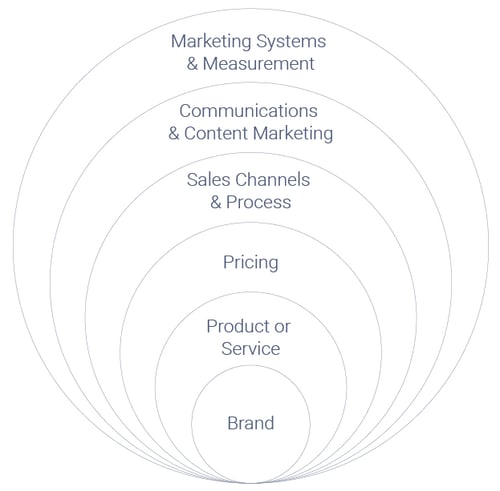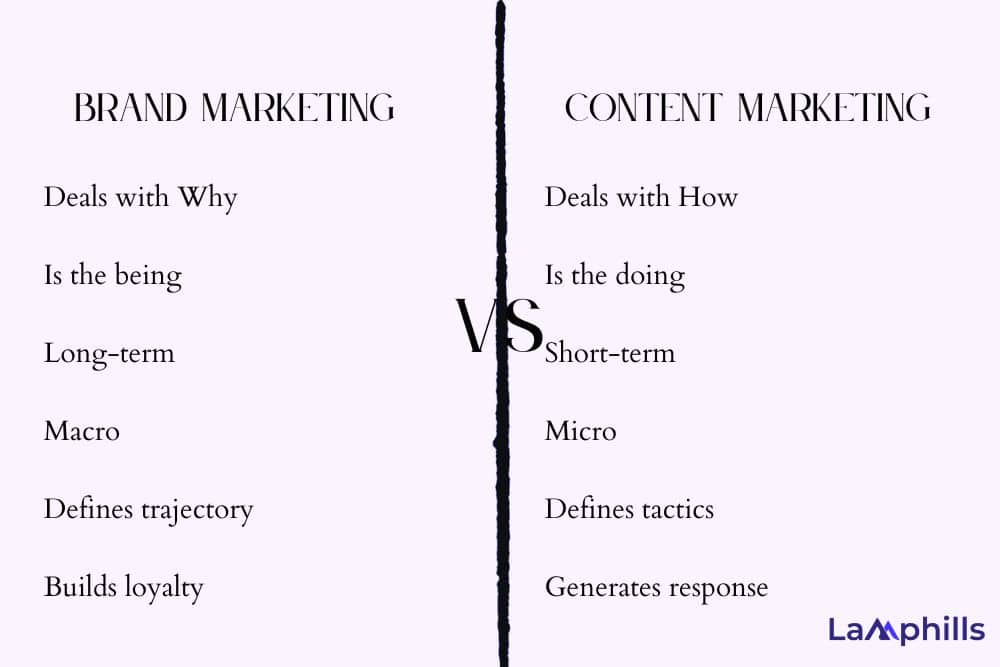What is the difference between brand marketing vs content marketing? However, I think the right question should be “what brings them together?” Because, in the world of PR and marketing, content isn’t just king… it’s queen, prince, princess.
In fact, it’s the whole monarchy, including the distant cousins.
When it comes to commercial content, there aren’t just several types — from blogs and videos, to podcasts and social media posts — but various approaches. Two of the forerunners, however are brand marketing and content marketing.
So, what do both strategies involve, and what is the difference between brand marketing vs content marketing?
Key Takeaways
- Brand marketing is all about crafting a unique and relatable identity for your company that resonates with your target audience.
- This creates a lasting impression and emotional connection in people’s minds.
- Crafting an effective brand marketing strategy is a vital endeavor for any business seeking to build brand recognition and thrive in the competitive marketplace.
- Content marketing is a marketing strategy used to attract, engage, and retain an audience by creating and sharing relevant articles, videos, podcasts, and other media.
- This approach establishes expertise, promotes brand awareness, and keeps your business top of mind when it’s time to buy what you sell.
- When done right, an effective content marketing strategy can increase visibility, generate more leads, boost loyalty, and improve authority.
What is Brand Marketing?
Brand marketing is the strategic process of creating a unique and compelling identity for a business to build strong connections and loyalty with its target audience. It is the process of marketing your brand and building brand value. Instead of raising awareness about a new product, brand marketing aims to raise awareness about your brand as a whole, and drive interest in the core values, purpose, and messages that define your brand.
To break it down a bit, brand marketing is like giving your business a personality and making sure it’s the kind with which everyone wants to be friends. It’s all about crafting a unique and relatable identity for your company that resonates with your target audience, creating a lasting impression and emotional connection in people’s minds.
Through clever storytelling, eye-catching visuals, and consistent messaging, brand marketing aims to build trust and loyalty with customers.
Remember that feeling when you stumble upon a brand that just “gets” you? That’s the magic of brand marketing at work, making customers feel connected and excited about what you have to offer.
Brand Marketing vs Content Marketing: Strategies For Creating A Brand Marketing Strategy
Crafting an effective brand marketing strategy is a vital endeavor for any business seeking to build brand recognition and thrive in the competitive marketplace. By following these seven essential steps, you can establish a compelling brand identity that resonates with your target audience, fosters brand loyalty, and propels your business to new heights.
Let’s delve into the key elements that will guide you in creating a successful brand marketing strategy.
How to create a brand marketing strategy
Examples of Brand Marketing
Let’s talk about Nike. In my opinion, Nike does a stellar job of brand marketing.
By consistently sticking with their “Just do it.” tagline, they have stood for and continue to stand for empowerment. They reinforce this by sponsoring athletes who inspire the world to be more and do better. They also reinforce this by telling stories of the everyday athlete, like in their “Find Your Greatness” ad, one of my all-time favorite ads.
Nike doesn’t have to talk about the quality of their products because they so clearly brand themselves as the brand that empowers people to “just do it”. Because of their focus on empowerment throughout the years, Nike as a brand means something to people. And having a strong brand means you can drive consumer preference for your product.
Brand marketing works. I’d venture to guess that if you’re in the market for a new pair of running shoes, chances are you’re going to consider Nike.
Brand Marketing vs Content Marketing: What is Content Marketing?
Content marketing is the development and distribution of relevant, useful content—blogs, newsletters, white papers, social media posts, emails, videos, and the like—to current and potential customers. When it’s done right, this content conveys expertise and makes it clear that a company values the people to whom it sells.
Content marketing is a go-to tactic that’s proven to work. Also, it provides a competitive advantage. Take a look at what the data says about content marketing:
- Businesses with blogs get 67% more leads than other companies.
- 67% of business-to-business (B2B) marketers say B2B content marketing increases engagement and the number of leads they generate.
- 88% of people credit branded videos for convincing them to purchase a product or service.
The consistent use of content marketing establishes and nurtures relationships with your prospective and existing customers. When your audience thinks of your company as a partner interested in their success and a valuable source of advice and guidance, they’re more likely to choose you when it’s time to buy.
Brand Marketing vs Content Marketing: Strategies For Content Marketing
How can you effectively create and promote your content to have a chance of competing, and gain consistent, legitimate traffic?
Here are 8 priceless content marketing tips and strategies, which are the ideal starting point to get more value out of your blog content.
Strategies For Content Marketing
Brand Marketing vs Content Marketing: Benefits of Content Marketing
Content marketing benefits businesses in many ways. When done right, an effective content marketing strategy can:
- Increase online visibility. A content strategy can help you attract more customers and website visitors, especially when people are constantly looking for solutions to their pain points. Offering educational and informative content about a topic they’re interested in can help you increase visibility online through your website or social media accounts.
- Generate more leads. You can increase leads when content marketing is used to drive traffic. Since educating customers builds trust and helps them feel more comfortable purchasing from your business, you can generate more leads and start to develop relationships with potential shoppers.
- Boost loyalty. Loyalty is essential in marketing and business because the more loyal your customers are, the more repeat purchases they’ll make. Offering content that informs consumers can help them begin to build trust with your brand and see you as a thought leader.
- Improve authority. Developing content is ideal for improving authority and becoming a thought leader in your industry. Not only does content help you build trust, but it can position your brand as the most authoritative on a particular topic.
Examples of Content Marketing
Luckily, we don’t need to go far to find an example of content marketing. This blog that you’re reading right now is a form of content marketing. Our goal at LampHills is to provide quality information and tips to business owners who are looking for public relations and marketing tips.
Daily blogging is part of LampHill’s overall content marketing strategy. Being helpful and helping companies grow their business is part of our overall brand strategy.
Brand Marketing vs Content Marketing: Which Comes First?
The short answer to this question, is that brand marketing should lead content marketing and any other form of marketing for that matter. Content marketing is just one of the many ways you can implement your brand strategy.
Brand Marketing, on the other hand, provides the lens in which all marketing decisions should be made.

Neither are mutually exclusive and should be used in conjunction with each other.
Content Marketing basically stems from the idea of providing information of value to your prospects and customers as a means of attracting attention, generating leads and sales, and building loyalty.
While Brand Marketing is a concept that stems from the idea that a well-defined brand creates demand pull or preference by ensuring all marketing elements are in sync with the brand positioning. A company’s brand represents their market identity—who they are, what they do, how they do what they do, where they make themselves available and what kind of quality they provide. Indeed, their reputation for trustworthiness.
Ultimately, brand marketing is the integrated story your business tells the world. Its key goal is to create sustainable demand, coupled with pricing resilience. Therefore, it is important to nearly all businesses; from those selling soup, to those developing new bio-technologies.
Brand Marketing vs Content Marketing: Key Differences
Brand Marketing aims to influence the decisions of a variety of customers and stakeholders, including both end consumers and businesses. The more compelling the brand is, the more effective for developing trial and repeat business.
Brand Marketing is the story that manages the customer’s perception of a brand. The more familiar they become through their previous experience with that brand, the greater the chances of achieving the brands business objectives.

Brand marketing covers:
- The marketing mix 4 or 7Ps (depending on your point of view)
- Your core value proposition
- Your differentiation messaging
- Your unique selling points
- The experiences your customers have using your products and/or services
- How your sales teams communicate with customers
- How your customer support team communicates with customers
- Any coverage of your brand in the media
Content Marketing covers:
Content Marketing on the other hand is a tactic of brand marketing although strategic in its nature and often used in isolation to Brand Marketing. It specifically stops trying to influence and persuade, instead relies on engaging via publishing educational and promotional content to help prospects and customers with their critical questions along their buyers’ journey.
With content marketing, brands become publishers, creating content around topics they know their audiences will resonate with. Brands do this to:
- Attract new prospects
- Engage leads
- Create and delight customers
Typically, the most common types of marketing content that business publish cover:
- Website pages
- Blog posts
- Pillar pages
- Videos
- Whitepapers
- Infographics
- E-books
- Quizzes
- Information guides
- Webinars and events
- GIFs
- Memes
Brand Marketing vs. Content Marketing: The Ideal Strategy
Ideally, a good marketing strategy should use a combination of both brand marketing and content marketing. A strong brand foundation is necessary so that you can create content marketing that is truly differentiated and that resonates with your target audience.
Great content doesn’t just pull customers to you. It encompasses your brand. If you haven’t already, you should establish brand guidelines that include keywords that describe your company, the tone of voice that every website landing page and blog post should include, and the overall visuals that you want to show your target audience.
You should of course include SEO-friendly content across all your online platforms. However, if your content creation doesn’t follow guidelines to help support the brand itself, your content marketing strategy could confuse your customers by communicating different messages.
The most successful marketing strategies combine content marketing and brand marketing in one cohesive message.
How To Develop A Strategy That Merges Brand Marketing With Content Marketing
Every successful campaign involves a well-developed strategy. Here are a few things to keep in mind as you construct your road map to merge your brand marketing with content marketing:
- Identify your ideal buyer persona, and determine where they will find you. Is your demographic on social media platforms like Facebook and Twitter, or is it more likely that they’ll hear about you on a radio or television commercial?
- Establish brand guidelines so that your content creators know what keywords and tone to include in the branded content.
- Research what your competitors are doing on their website and social media What’s working for them, and what’s not? Apply this knowledge to boost your marketing campaigns.
- Create a content calendar that outlines your action items. Assign a date to each blog post and social media. This will help you consistently communicate with your audience.
- Outline an interactive social media campaign to engage with your audience. This might be a poll, a contest, or even an infographic that will educate them.
Once you’ve developed your strategy, stick to it! When you have a cohesive road map, it’s easy to merge your brand and content marketing so that you can produce great content within your brand guidelines.
Recommended Articles
- How to Develop a Creative Strategy Like a Pro: Tips, Examples, and Templates
- Top 5 Brand Pillars: Why Your Business Can’t Afford to Ignore Them!
- The Power of Trust in Marketing: How to Build Strong Connections With Customers
- Backlinks Removal: Protecting Your Site from Harmful Links
- A Complete Guide to Building Niche Relevant Backlinks
- 6 Tips for Choosing the Best Domain Extensions for SEO in 2024






